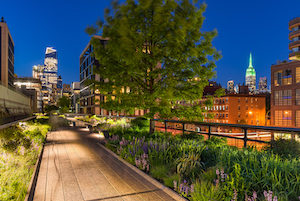How to Prepare for NYC’s Mandate to Reduce Greenhouse Gases 80% by 2050
By George Crawford
 The City Council’s recent passage of Int. No. 1253—part of New York City’s Green New Deal—calls for an 80% reduction of greenhouse gases in the five boroughs by 2050. This legislation, which was signed by the mayor on May 31, establishes very significant fines in the form of penalty taxes.
The City Council’s recent passage of Int. No. 1253—part of New York City’s Green New Deal—calls for an 80% reduction of greenhouse gases in the five boroughs by 2050. This legislation, which was signed by the mayor on May 31, establishes very significant fines in the form of penalty taxes.
Achieving this mandated goal will require evaluation of buildings on the basis of total energy consumption, which includes electricity, as well as fuel for heating and hot water. The city is prepared to set emission limits on the burning of fossil fuels, such as oil, gas, and coal, but a better—and more cost-effective—solution is to reduce electricity consumption as soon as possible, before the city imposes such limits.
Decrease Electric Bills
Buildings can reduce their electricity consumption in two steps. First, proceed with implementing Local Law 88 requirements, including the LED upgrade for common areas in multifamily properties and the building-wide LED upgrades in commercial properties. Doing so will result in significant savings, reducing electricity consumption by 50% on overage. The lower consumption level will allow building owners to determine their properties’ standings in terms of New York City’s new energy consumption requirements.
Residential buildings should consider taking the LED upgrade a step further by encouraging residents—on a voluntary basis—to switch to LED lighting. Some assistance may be required to ensure that LED replacement products meet aesthetic requirements in apartments, but the energy reduction is well worth this effort.
Owners of commercial properties should note that Local Law 88 assigns responsibility for LED upgrades to landlords, not tenants. However, landlords can enter into agreements with office tenants to share the electrical savings. Such arrangements will allow tenants to benefit from lower electric costs, while helping landlords to recoup upgrade costs. A 50-50 split of the savings should reimburse landlords in approximately four years.
Additional mandates tie into the 80% carbon reduction goal. For instance, starting in 2022, the city will enforce building emissions restrictions for properties that do not meet benchmarking goals. The proposed local law would require registered design professionals to conduct annual audits of every building of 25,000 s.f. and larger. Non-compliance would result in huge fines, leaving building owners little choice but to comply. Consequently, buildings should complete all LED upgrades well before 2022, when the limits on building emissions go into effect.
Explore Tax Strategies
Since meeting these mandates will likely require a financial investment, building owners should reach out to their accountants to discuss available tax-advantaged strategies. For instance, it may be helpful to review EPAct 179D, which applies to buildings that pay taxes, such as commercial buildings and hotel and rental properties. This tax provision allows immediate deductions for the cost of energy-saving measures to offset income, as opposed to an amortization schedule that allows gradual deductions against income.
If your accountant is not set up to handle EPAct 179D submissions, a small group of tax providers have the qualifications and computer capabilities to meet these requirements and can coordinate the related tax preparation with your current provider. You’ll need to provide the details or drawings of your LED or energy savings project. Most of these specialized tax providers will review projects on a complimentary basis. They typically charge a small fee, based on tax savings, to proceed with the actual documentation and required computer model.
George Crawford leads Green Partners LLC, which identifies money-saving solutions for owners of commercial and residential properties in New York City. For help with your energy needs, please contact George by email at gcrawford@greenpartnersny.com.

